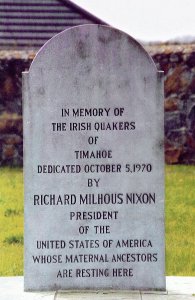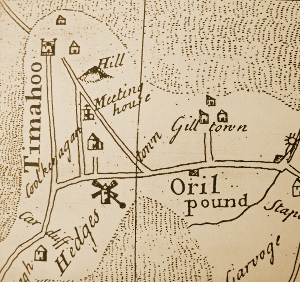An American Presidential Visit
to County Kildare
Published in the Kildare Nationalist, 20th March 2009
In 1970 President Richard Nixon paid an official visit to Ireland primarily to visit his maternal ancestral burial ground at Hodgestown close to Timahoe. It was the second American Presidential visit to the country; the first took place seven years earlier in 1963 when President Kennedy visited his family’s ancestral home in County Wexford. Nixon had Irish connections on both the maternal and paternal side of the family. His Kildare connections came from his Mother, Hannah Milhouse. Her ancestor Thomas Milhouse of Timahoe emigrated to Pennsylvania in 1729.
The Milhouses were members of a Quaker community that were prominent in the Timahoe area throughout the early 18th century. The community first emerged in 1704 when a number of families purchased the leasehold of Timahoe and Gilltown in the Barony of Clane in North Kildare. They came mainly from Ulster and did not exceed 10 families at any one time. Within a short period of time a meeting house was built and a new burial ground acquired. They also built a Windmill and developed the land in Timahoe and the surrounding townlands. This greatly added to the development of agriculture in the area. However, the Quakers suffered persecution and even imprisonment for their religion. The community soon declined due to emigration which took place in two phases. Firstly, a group immigrated to Pennsylvania in 1729. Included in the group were Thomas Milhouse and his wife Sarah Mickle. They were the ancestors of Richard Nixon. Then in 1751 a second group left and settled in South Carolina.
The story of the Timahoe Quakers continued in the United States. They prospered and multiplied, however, they suffered persecution during the American Revolution when they refused for religious reasons to join the local militia who were fighting against the British. Then, in the years preceding 1860, descendents of the Timahoe Quakers in the Southern States became involved in anti-slavery activity and assisted run away slaves. In 1885 Hannah Milhouse a fourth great granddaughter of Thomas and Sarah was born in Ohio. She married Frank Nixon in 1912. Frank was a Methodist of Northern Irish extraction and he joined the Quaker religion on his marriage. In 1913 their eldest son Richard, the future President of United States was born. As a boy he was told by his mother of her Irish connection and that the last place where the family lived in the old world was Timahoe, country Kildare, Ireland.
The Nixons had moved to California shortly after their marriage and Richard qualified as an attorney. He went into politics and by the early 1950’s was a member of the Senate in Washington. In 1952 as General Eisenhower’s running mate he was elected Vice President of the United States.
The same year Nixon’s aunt, Rose Milhouse and her husband visited Timahoe. She was the first member of the Milhouse family to visit Timahoe since her ancestors emigrated in the 18th century. Among the sites she visited was the Quaker burial ground at Hodgestown where three of her ancestors are interred. Subsequently details of the Nixon-Milhouse family tree which detailed the County Kildare connection were published in the United States.
Nixon’s defeat in the 1960 presidential election at the hands of Jack Kennedy was largely the result of Kennedy gaining the ‘Irish vote’. Nixon realized after the election that if he had disclosed his own Irish background it could have put him ahead of Kennedy in the election. He made a comeback in 1968 and won the Presidential election. During his first year in office he decided to make an official trip to Ireland and include a visit to the home of his Quaker ancestors in Kildare. A visit to his Irish roots would greatly enhance the prospects of re-election in the 1972 contest. Contact was made with the Irish government and by the summer of 1970 rumors began to circulate that there would be a Presidential visit to Ireland with Timahoe mentioned as the venue. An invitation for President Nixon to visit Northern Ireland where his paternal ancestors had originated was made by the Northern Premier Captain Terence O’Neill. However, President Nixon declined to take up the offer.
In preparation for the visit the American Ambassador visited Timahoe in July 1970 and looked at the Quaker burial ground at Hodgestown. Kildare county council now became involved and suggested that the President also visit Ballytore a village built by Quakers. The American organizers rejected this proposal but agreed to a Presidential tour of some towns in the county.
There was a massive clean up of the entire Timahoe area and the county council filled pot holes for miles around, hedges on both sides of the roads along the route the President would take were cut and the Post and Telegraphs connected many new phones lines in the area. There was a clean up of the Quaker Burial ground at Hodgestown and the outline of the Meeting house was uncovered. The owner of the Pub in Timahoe James Brady even suggested that he might rename his pub ‘The Nixon Arms’.

Milhouse-Nixon Memorial in Hodgestown Burial Ground, Timahoe
This illustration also appears in The Road on the Long Ridge by Hermann Geissel, on page 26
The Visit took place on Monday 5th October 1970. There were almost 1000 people gathered in the field beside the Quaker burial ground, many of them members of the media. The President accompanied by his wife Pat, arrived and were greeted by a number of people, including; members of the Irish Quaker community; the local councilor Hugh Cosgrave and the oldest man in the district 99 year old Tom Cummins. The President was then presented with documentary evidence of his Irishness by Olive Goodbody one of the leading Quaker historians in Ireland. It included details of the Milhouse families connection with Timahoe and a copy of a certificate of removal that Thomas Milhouse was granted by the Dublin meeting on his departure from Timahoe in 1729.
There was a presentation on behalf of the local people. Michael Maguire presented the President with a piece of inscribed granite and Mrs. Nixon was presented with a bouquet of flowers by Sadie Heffernan. The party were then entertained by the Artane boys band. The President unveiled a monument in the burial ground and became visibly moved when he read the wording.
In his speech he spoke in gratification about the monument and the welcome from local people and the schoolchildren. Referring to religious conflict in Ireland he spoke of the tolerance of Irish Catholics towards Quakers. He walked around the burial ground and looked at the outline of the meeting house which was shaped by raised sods.
The visit to Timahoe lasted about 40 minutes before the Nixon motorcade left for a tour of county Kildare towns. The motorcade drove through the countryside to Kildare town and were entertained by 8 members of the Gilroy school of dancing who put on a display of Irish dancing. Throngs of people gathered around the Presidential car as it passed through Newbridge with the Patrician boys band playing traditional American and Irish airs. The Presidential car then passed through Naas, cheered on by local school children before reaching the race-course where the Army number one helicopter awaited them. Before boarding for Dublin the President thanked the Gardai on duty for providing security during his trip to county Kildare. Arriving in Dublin the President had a meeting with the Taoiseach Jack Lynch and President Eamon De Valera.
At the present time, the local St. Mochua Historical Society cares for the Quaker burial ground and Quaker anniversary events are commemorated. One important event occurred in 2004 when the Society organised a tri-centenary event to mark the arrival of the first Quakers to Timahoe in 1704. Today, it is fair to say that the Quaker and the Nixon-Milhouse connection have not been forgotten and are highly regarded by the local community in Timahoe.

